Extended Residual-State Creep Test and Its Application for Landslide Stability Assessment
Abstract
1. Introduction
2. Materials and Methods
2.1. Creep Tests—Creep Test Apparatus and Test Methods
2.2. Creep Test on Clayey Soils
2.3. Fractional Integrals and Derivatives
2.4. Filtering and Fitting Calculation Results
2.5. Water Flow in Unsaturated Substrate
2.6. Application of the Proposed Model—Case Study
- Duration of the experiment: 1000 h;
- Minimum value of time increment: 0.01 h;
- The maximum value of time increment: 1.0 h;
- Maximum of 200 iterations;
- Soil water characteristic curve (SWCC) without hysteresis;
- Upper bound condition (along z axis) constant pressure head;
- Lower bound condition (along z axis) free drainage;
- Initial condition as pressure heads.
3. Results and Discussion
4. Conclusions
Author Contributions
Funding
Institutional Review Board Statement
Informed Consent Statement
Data Availability Statement
Acknowledgments
Conflicts of Interest
References
- Fell, R.; Corominas, J.; Bonnard, C.; Cascini, L.; Leroi, E.; Savage, W. On Behalf of the JTC-1 Joint Technical Committee on Landslides and Engineered Slopes (2008) Guidelines for Landslide Susceptibility, Hazard and Risk Zoning for Land Use Planning. Eng. Geol. 2008, 102, 85–98. [Google Scholar] [CrossRef]
- Van Westen, C.J.; Castellanos, E.; Kuriakose, S.L. Spatial Data for Landslide Susceptibility, Hazard, and Vulnerability Assessment: An Overview. Eng. Geol. 2008, 102, 112–131. [Google Scholar] [CrossRef]
- Le, Q.H.; Nguyen, T.H.V.; Do, M.D.; Le, T.C.H.; Pham, V.S.; Nguyen, H.K.; Luu, T.B. TXT-Tool 1.084-3.1: Landslide Susceptibility Mapping at a Regional Scale in Vietnam. In Landslide Dynamics: ISDR-ICL Landslide Interactive Teaching Tools: Volume 1: Fundamentals, Mapping and Monitoring; Sassa, K., Guzzetti, F., Yamagishi, H., Arbanas, Ž., Casagli, N., McSaveney, M., Dang, K., Eds.; Springer International Publishing: Cham, Switzerland, 2018; pp. 161–174. [Google Scholar] [CrossRef]
- Dietrich, W.; Montgomery, D. A Digital Terrain Model for Mapping Shallow Landslide Potential. Univ. Calif.-Univ. Wash. 1998. Available online: http://calm.geo.berkeley.edu/geomorph/shalstab/index.htm (accessed on 12 April 2021).
- Rossi, G.; Catani, F.; Leoni, L.; Segoni, S.; Tofani, V. Hiresss: A Physically Based Slope Stability Simulator for HPC Applications. Nat. Hazards Earth Syst. Sci. 2013, 13, 151–166. [Google Scholar] [CrossRef]
- Tianbin, L.; Mingdong, C. Time Prediction of Landslide Using Verhulst Inverse-Function Model. J. Geol. Hazards Enveronment Preserv. 1996, 3, 13–17. [Google Scholar]
- Stedinger, J.R.; Vogel, R.M.; Lee, S.U.; Batchelder, R. Appraisal of the Generalized Likelihood Uncertainty Estimation (GLUE) Method. Water Resour. Res. 2008, 44, 12. [Google Scholar] [CrossRef]
- Kim, J.; Jeong, S.; Park, S.; Sharma, J. Influence of Rainfall-Induced Wetting on the Stability of Slopes in Weathered Soils. Eng. Geol. 2004, 75, 251–262. [Google Scholar] [CrossRef]
- Jeong, S.; Lee, K.; Kim, J.; Kim, Y. Analysis of Rainfall-Induced Landslide on Unsaturated Soil Slopes. Sustainability 2017, 9, 1280. [Google Scholar] [CrossRef]
- Chen, X.; Guo, H.; Song, E. Analysis Method for Slope Stability under Rainfall Action. Landslides Eng. Slopes 2008, 7, 1507–1515. [Google Scholar]
- Ponziani, F.; Pandolfo, C.; Stelluti, M.; Berni, N.; Brocca, L.; Moramarco, T. Assessment of Rainfall Thresholds and Soil Moisture Modeling for Operational Hydrogeological Risk Prevention in the Umbria Region (Central Italy). Landslides 2012, 9, 229–237. [Google Scholar] [CrossRef]
- Intrieri, E.; Carlà, T.; Gigli, G. Forecasting the Time of Failure of Landslides at Slope-Scale: A Literature Review. Earth-Sci. Rev. 2019, 193, 333–349. [Google Scholar] [CrossRef]
- Rosser, N.; Lim, M.; Petley, D.; Dunning, S.; Allison, R. Patterns of Precursory Rockfall Prior to Slope Failure. J. Geophys. Res. Earth Surf. 2007, 112. [Google Scholar] [CrossRef]
- Vilhelm, J.; Rudajev, V.; Lokajíček, T.; Živor, R. Application of Autocorrelation Analysis for Interpreting Acoustic Emission in Rock. Int. J. Rock Mech. Min. Sci. 2008, 45, 1068–1081. [Google Scholar] [CrossRef]
- Singh, D.P. A Study of Creep of Rocks. Int. J. Rock Mech. Min. Sci. Geomech. Abstr. 1975, 12, 271–276. [Google Scholar] [CrossRef]
- Hunter, G.J.; Khalili, N. A Simple Criterion for Creep Induced Failure of Over-Consolidated Clays. In Proceedings of the ISRM International Symposium. International Society for Rock Mechanics and Rock Engineering, Melbourne, Australia, 19 November 2000. [Google Scholar]
- Petley, D.; Mantovani, F.; Bulmer, M.; Zannoni, F. The Interpretation of Landslide Monitoring Data for Movement Forecasting. Geomorphology 2005, 66, 133–147. [Google Scholar] [CrossRef]
- Feda, J. Interpretation of Creep of Soils by Rate Process Theory. Géotechnique 1989, 39, 667–677. [Google Scholar] [CrossRef]
- Augustesen, A.; Liingaard, M.; Lade, P.V. Evaluation of Time-Dependent Behavior of Soils. Int. J. Geomech. 2004, 4, 137–156. [Google Scholar] [CrossRef]
- Brandes, H.G.; Nakayama, D.D. Creep, Strength and Other Characteristics of Hawaiian Volcanic Soils. Géotechnique 2010, 60, 235–245. [Google Scholar] [CrossRef]
- Ter-Stepanian, G. Creep of a Clay during Shear and Its Rheological Model. Géotechnique 1975, 25, 299–320. [Google Scholar] [CrossRef]
- Leoni, M.; Karstunen, M.; Vermeer, P.A. Anisotropic Creep Model for Soft Soils. Géotechnique 2008, 58, 215–226. [Google Scholar] [CrossRef]
- Yin, Z.-Y.; Chang, C.S.; Karstunen, M.; Hicher, P.-Y. An Anisotropic Elastic–Viscoplastic Model for Soft Clays. Int. J. Solids Struct. 2010, 47, 665–677. [Google Scholar] [CrossRef]
- Cascini, L.; Calvello, M.; Grimaldi, G.M. Groundwater Modeling for the Analysis of Active Slow-Moving Landslides. J. Geotech. Geoenviron. Eng. 2010, 136, 1220–1230. [Google Scholar] [CrossRef]
- Bhat, D.R.; Wakai, A. Numerical Simulation of a Creeping Landslide Induced by a Snow Melt Water. Tech. J. 2019, 1, 71–78. [Google Scholar] [CrossRef][Green Version]
- Wang, S.; Wu, W.; Wang, J.; Yin, Z.; Cui, D.; Xiang, W. Residual-State Creep of Clastic Soil in a Reactivated Slow-Moving Landslide in the Three Gorges Reservoir Region, China. Landslides 2018, 15, 2413–2422. [Google Scholar] [CrossRef]
- Sharifzadeh, M.; Tarifard, A.; Moridi, M.A. Time-Dependent Behavior of Tunnel Lining in Weak Rock Mass Based on Displacement Back Analysis Method. Tunn. Undergr. Space Technol. 2013, 38, 348–356. [Google Scholar] [CrossRef]
- Tavenas, F.; Leroueil, S. Creep and Failure of Slopes in Clays. Can. Geotech. J. 1981, 18, 106–120. [Google Scholar] [CrossRef]
- Amitrano, D.; Helmstetter, A. Brittle Creep, Damage, and Time to Failure in Rocks. J. Geophys. Res. Solid Earth 2006, 111. [Google Scholar] [CrossRef]
- Saito, M. Forecasting the Time of Occurrence of a Slope Failure. In Proceedings of the 6th International Conference Soil Mechanics and Foundation Engineering, Montreal, QC, Canada, 8–15 September 1965; pp. 537–541. [Google Scholar]
- Saito, M. Forecasting Time of Slope Failure by Tertiary Creep. In Proceedings of the 7th International Conference on Soil Mechanics and Foundation Engineering; Sociedad Mexicana de Mecánica de Suelos: Mexico City, Mexico, 1969; Volume 2, pp. 677–683. Available online: https://citeseerx.ist.psu.edu/viewdoc/download?doi=10.1.1.612.2877&rep=rep1&type=pdf (accessed on 12 April 2021).
- Federico, A.; Popescu, M.; Murianni, A. Temporal Prediction of Landslide Occurrence: A Possibility or a Challenge. Ital. J. Eng. Geol. Environ. 2015, 1, 41–60. [Google Scholar]
- Chen, H.; Lee, C.F. A Dynamic Model for Rainfall-Induced Landslides on Natural Slopes. Geomorphology 2003, 51, 269–288. [Google Scholar] [CrossRef]
- Antolini, F.; Barla, M.; Gigli, G.; Giorgetti, A.; Intrieri, E.; Casagli, N. Combined Finite–Discrete Numerical Modeling of Runout of the Torgiovannetto Di Assisi Rockslide in Central Italy. Int. J. Geomech. 2016, 16, 04016019. [Google Scholar] [CrossRef]
- Atanacković, T.M.; Pilipović, S.; Stanković, B.; Zorica, D. Fractional Calculus with Applications in Mechanics; Wiley Online Library: Hoboken, NJ, USA, 2014. [Google Scholar]
- Diethelm, K. The Analysis of Fractional Differential Equations: An Application-Oriented Exposition Using Differential Operators of Caputo Type; Springer Science & Business Media: Berlin/Heidelberg, Germany, 2010. [Google Scholar]
- Kilbas, A.A.; Srivastava, H.M.; Trujillo, J.J. Theory and Applications of Fractional Differential Equations; Elsevier: Amsterdam, The Netherlands, 2006. [Google Scholar]
- Podlubny, I. Fractional Differential Equations: An Introduction to Fractional Derivatives, Fractional Differential Equations, to Methods of Their Solution and Some of Their Applications; Elsevier: Amsterdam, The Netherlands, 1998. [Google Scholar]
- Kilbas, A.A.; Marichev, O.; Samko, S. Fractional Integrals and Derivatives (Theory and Applications); Gordon and Breach Science Publishers: Yverdon, Switzerland, 1993. [Google Scholar]
- Paola, M.D.; Zingales, M. Exact Mechanical Models of Fractional Hereditary Materials. J. Rheol. 2012, 56, 983–1004. [Google Scholar] [CrossRef]
- Di Paola, M.; Pirrotta, A.; Valenza, A. Visco-Elastic Behavior through Fractional Calculus: An Easier Method for Best Fitting Experimental Results. Mech. Mater. 2011, 43, 799–806. [Google Scholar] [CrossRef]
- Di Paola, M.; Pinnola, F.P.; Zingales, M. A Discrete Mechanical Model of Fractional Hereditary Materials. Meccanica 2013, 48, 1573–1586. [Google Scholar] [CrossRef][Green Version]
- Di Paola, M.; Pinnola, F.P.; Zingales, M. Fractional Differential Equations and Related Exact Mechanical Models. Comput. Math. Appl. 2013, 66, 608–620. [Google Scholar] [CrossRef]
- Bishop, A.W.; Green, G.E.; Garga, V.K.; Andresen, A.; Brown, J.D. A New Ring Shear Apparatus and Its Application to the Measurement of Residual Strength. Géotechnique 1971, 21, 273–328. [Google Scholar] [CrossRef]
- Stark, T.D.; Eid, H.T. Modified Bromhead Ring Shear Apparatus. Geotech. Test. J. 1993, 16, 100–107. [Google Scholar] [CrossRef]
- Bromhead, E.N.; Dixon, N. The Field Residual Strength of London Clay and Its Correlation with Loboratory Measurements, Especially Ring Shear Tests. Géotechnique 1986, 36, 449–452. [Google Scholar] [CrossRef]
- Tiwari, B.; Brandon, T.L.; Marui, H.; Tuladhar, G.R. Comparison of Residual Shear Strengths from Back Analysis and Ring Shear Tests on Undisturbed and Remolded Specimens. J. Geotech. Geoenviron. Eng. 2005, 131, 1071–1079. [Google Scholar] [CrossRef]
- Hong, Y.; Yu, G.; Wu, Y.; Zheng, X. Effect of Cyclic Loading on the Residual Strength of Over-Consolidated Silty Clay in a Ring Shear Test. Landslides 2011, 8, 233–240. [Google Scholar] [CrossRef]
- Bhat, D.R.; Bhandary, N.P.; Yatabe, R. Method of Residual-State Creep Test to Understand the Creeping Behaviour of Landslide Soils. In Landslide Science and Practice: Volume 2: Early Warning, Instrumentation and Monitoring; Margottini, C., Canuti, P., Sassa, K., Eds.; Springer: Berlin/Heidelberg, Germany, 2013; pp. 635–642. [Google Scholar] [CrossRef]
- Bhat, D.R.; Bhandary, N.P.; Yatabe, R.; Tiwari, R.C. A New Concept of Residual-State Creep Test to Understand the Creeping Behavior of Clayey Soils. In Proceedings of the GeoCongress 2012: State of the Art and Practice in Geotechnical Engineering, Oakland, CA, USA, 25–29 March 2012; pp. 683–692. [Google Scholar] [CrossRef]
- Bhat, D.R. Residual-State Creep Test in Modified Torsional Ring Shear Machine: Methods and Implications. Int. J. Geomate 2011, 1, 39–43. [Google Scholar] [CrossRef]
- Bhat, D.R.; Yatabe, R.; Bhandary, N.P. Creeping Displacement Behavior of Clayey Soils in A New Creep Test Apparatus. In Proceedings of the Soil Behavior and Geomechanics, Shanghai, China, 26–28 March 2014; pp. 275–285. [Google Scholar] [CrossRef]
- Bhat, D.R.; Bhandary, N.P.; Yatabe, R. Residual-State Creep Behavior of Typical Clayey Soils. Nat. Hazards 2013, 69, 2161–2178. [Google Scholar] [CrossRef]
- Bhat, D.R.; Yatabe, R. Effect of Shearing Rate on Residual Strength of Landslide Soils. In Engineering Geology for Society and Territory; Lollino, G., Giordan, D., Crosta, G.B., Corominas, J., Azzam, R., Wasowski, J., Sciarra, N., Eds.; Springer International Publishing: Cham, Switzerland, 2015; Volume 2, pp. 1211–1215. [Google Scholar] [CrossRef]
- Bhat, D.R.; Yatabe, R.; Bhandary, N.P. Study of Preexisting Shear Surfaces of Reactivated Landslides from a Strength Recovery Perspective. J. Asian Earth Sci. 2013, 77, 243–253. [Google Scholar] [CrossRef]
- JIS. A 1202:2009 Test Method for Density of Soil Particles; JIS: Tokyo, Japan, 2009. [Google Scholar]
- JIS. A 1203:2009 Test Method for Water Content of Soils; JIS: Tokyo, Japan, 2009. [Google Scholar]
- JIS. A 1204:2009 Test Method for Particle Size Distribution of Soils; JIS: Tokyo, Japan, 2009. [Google Scholar]
- JIS. A 1205:2009 Test Method for Liquid Limit and Plastic Limit of Soils; JIS: Tokyo, Japan, 2009. [Google Scholar]
- Matsushi, Y.; Matsukura, Y. Cohesion of Unsaturated Residual Soils as a Function of Volumetric Water Content. Bull. Eng. Geol. Environ. 2006, 65, 449. [Google Scholar] [CrossRef]
- Simunek, J.; Van Genuchten, M.T.; Sejna, M. The HYDRUS-1D Software Package for Simulating the One-Dimensional Movement of Water, Heat, and Multiple Solutes in Variably-Saturated Media. Univ. Calif.-Riverside Res. Rep. 2005, 3, 1–240. [Google Scholar]
- Simunek, J.; Jacques, D.; van Genuchten, M.T.; Mallants, D. Multicomponent Geochemical Transport Modeling Using HYDRUS-1 D and HP 1. J. Am. Water Resour. Assoc. 2006, 42, 1537–1547. [Google Scholar] [CrossRef]
- Šimůnek, J.; Van Genuchten, M.T.; Šejna, M. The HYDRUS Software Package for Simulating Two-and Three-Dimensional Movement of Water, Heat, and Multiple Solutes in Variably-Saturated Media. Tech. Man. Version 2006, 1, 241. [Google Scholar]
- Van Genuchten, M.T. A Closed-Form Equation for Predicting the Hydraulic Conductivity of Unsaturated Soils. Soil Sci. Soc. Am. J. 1980, 44, 892–898. [Google Scholar] [CrossRef]
- Mualem, Y. A New Model for Predicting the Hydraulic Conductivity of Unsaturated Porous Media. Water Resour. Res. 1976, 12, 513–522. [Google Scholar] [CrossRef]
- Singh, V.P. Kinematic Wave Modeling in Water Resources: Environmental Hydrology; John Wiley & Sons: Hoboken, NJ, USA, 1997. [Google Scholar]

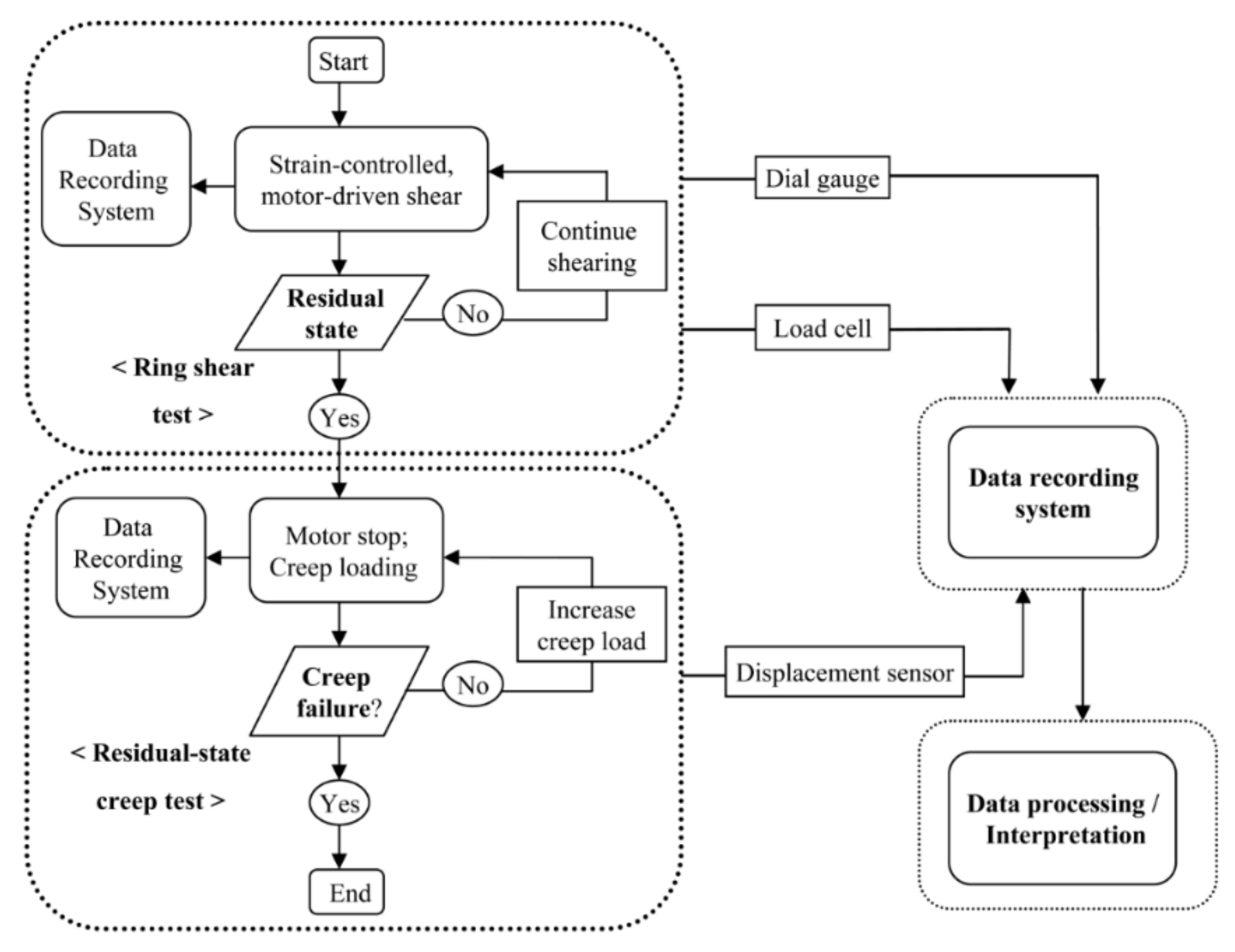

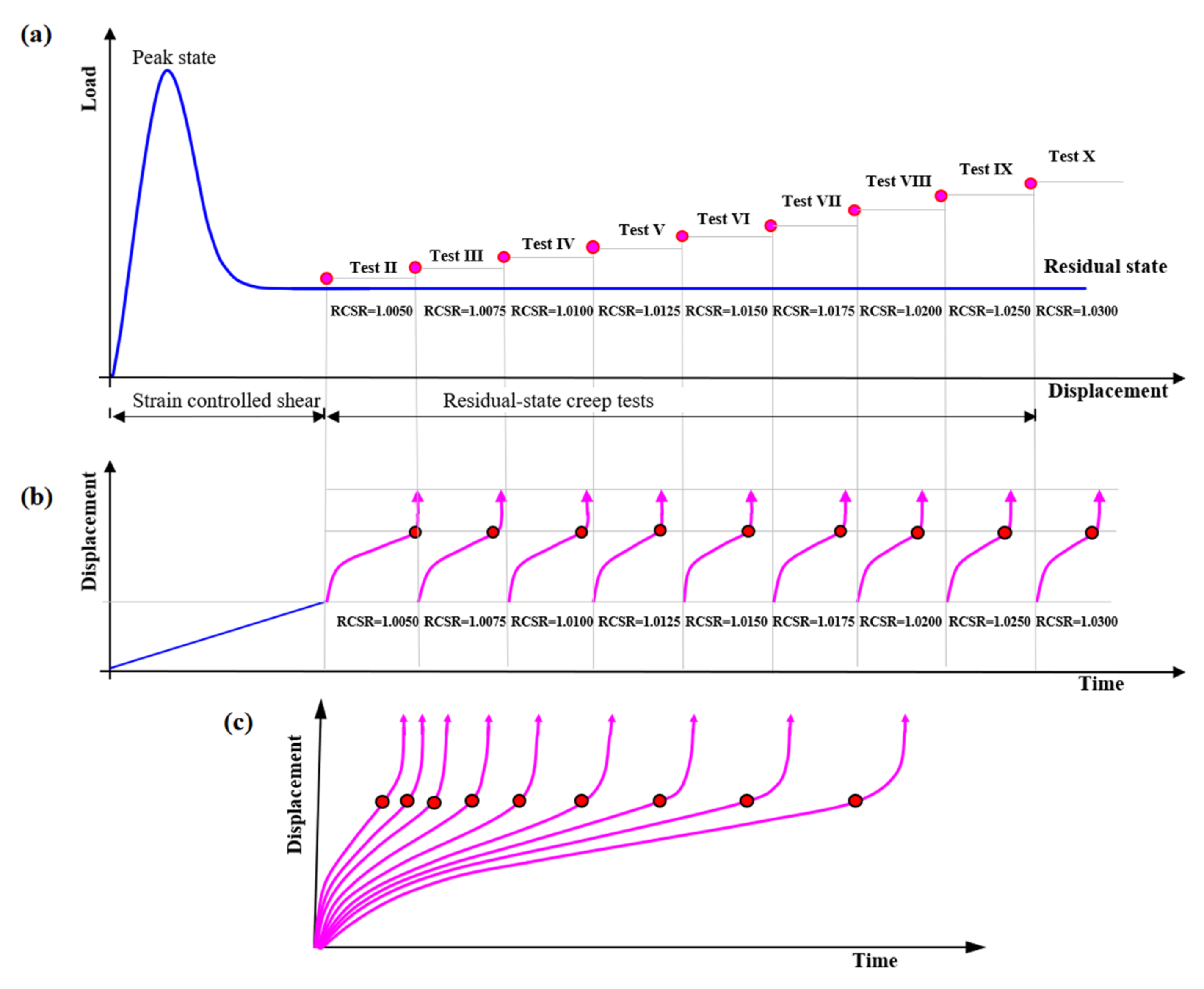
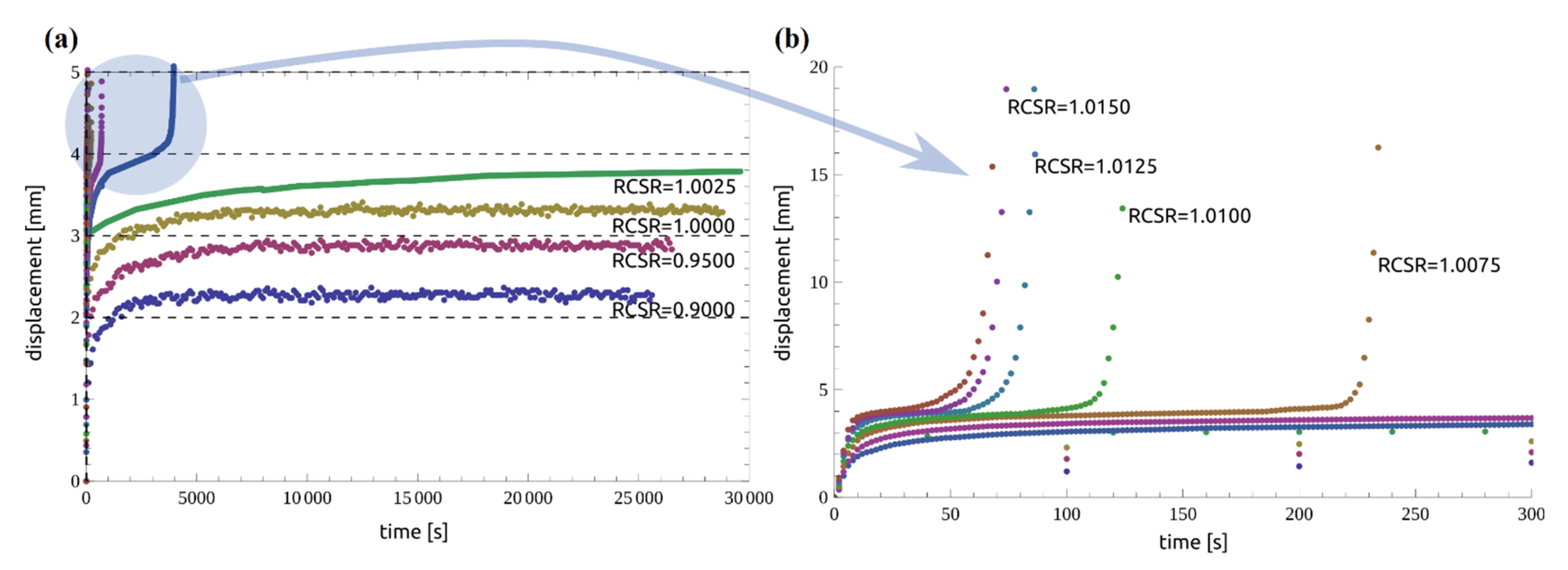

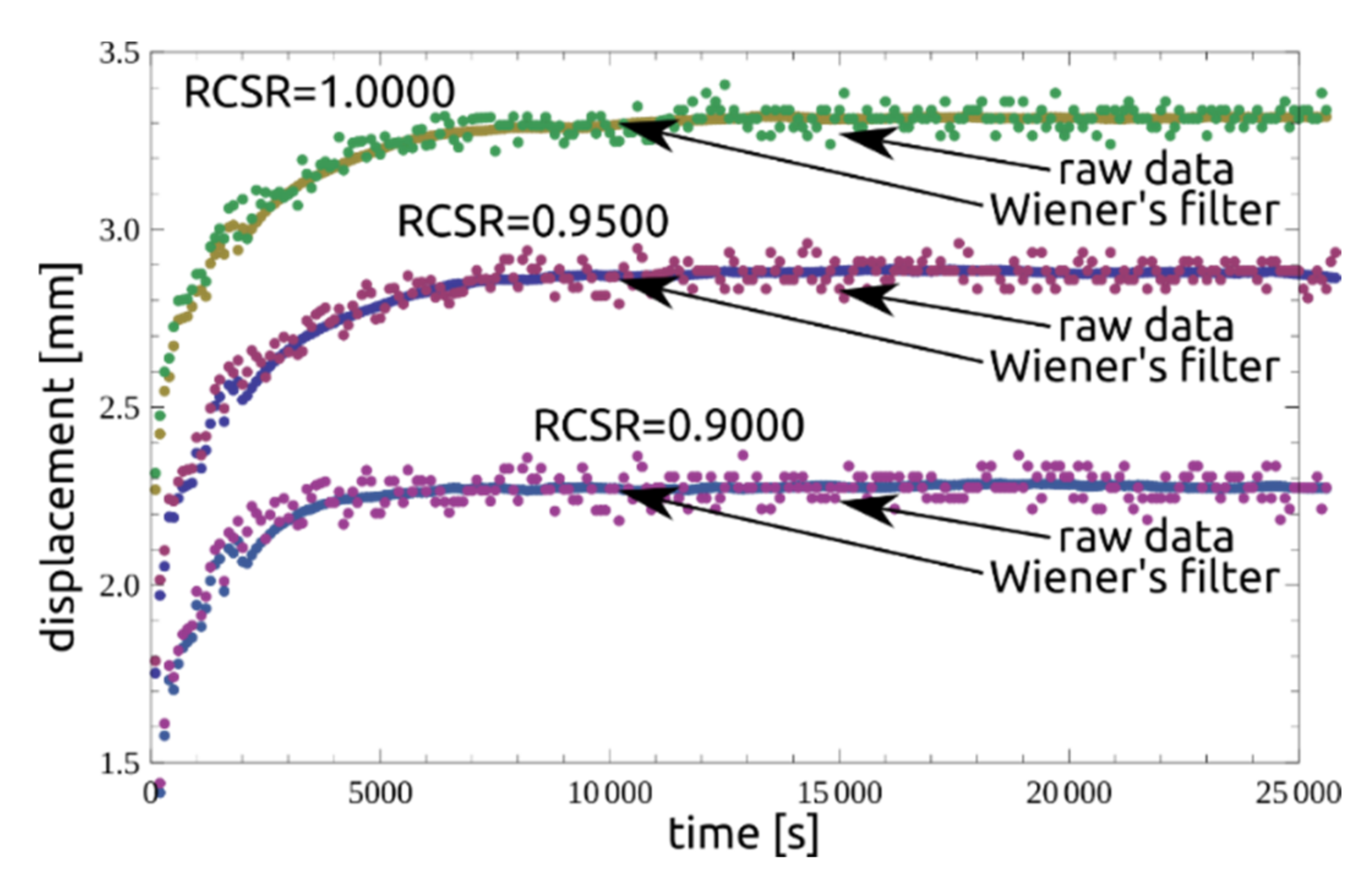


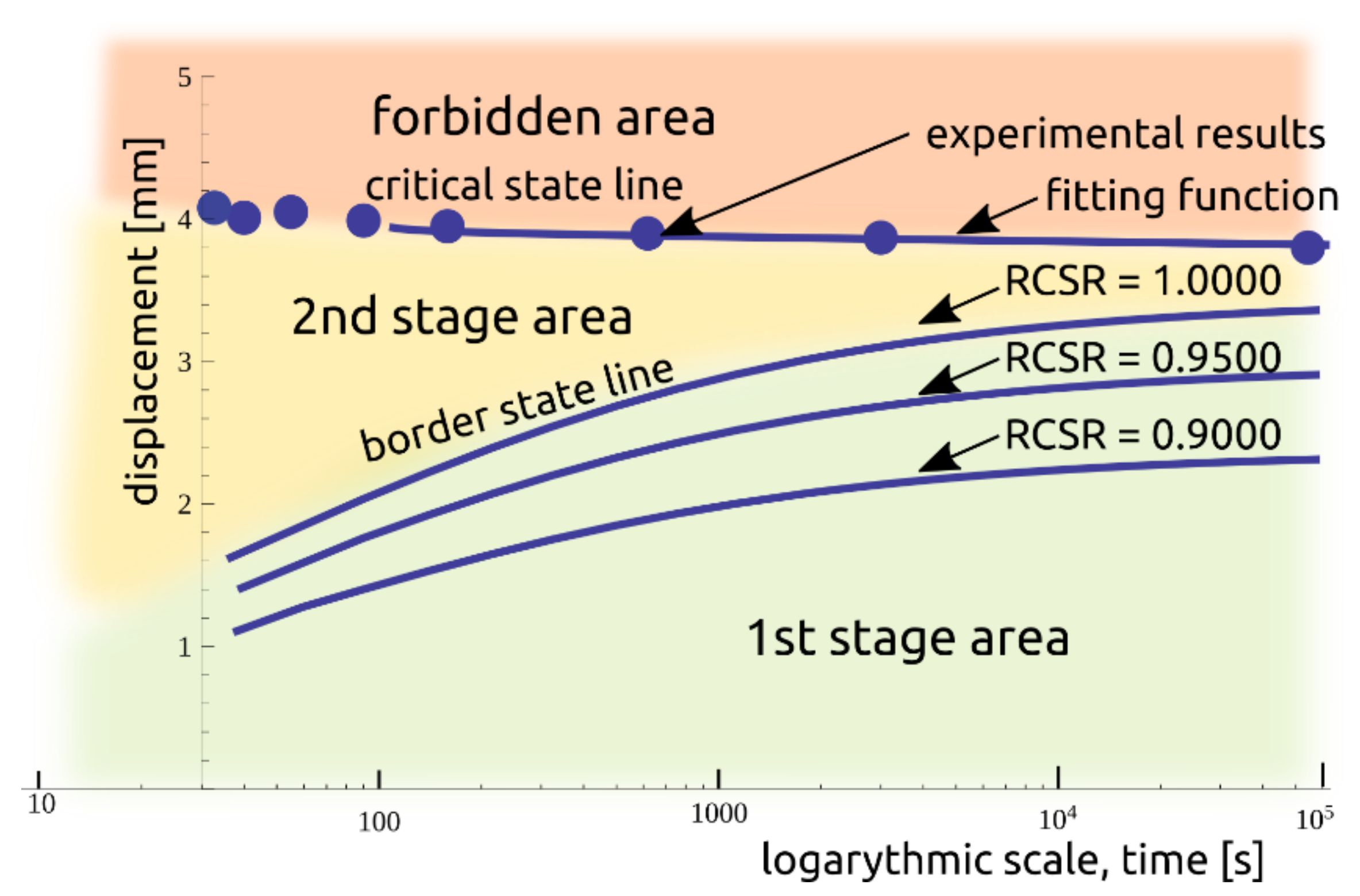
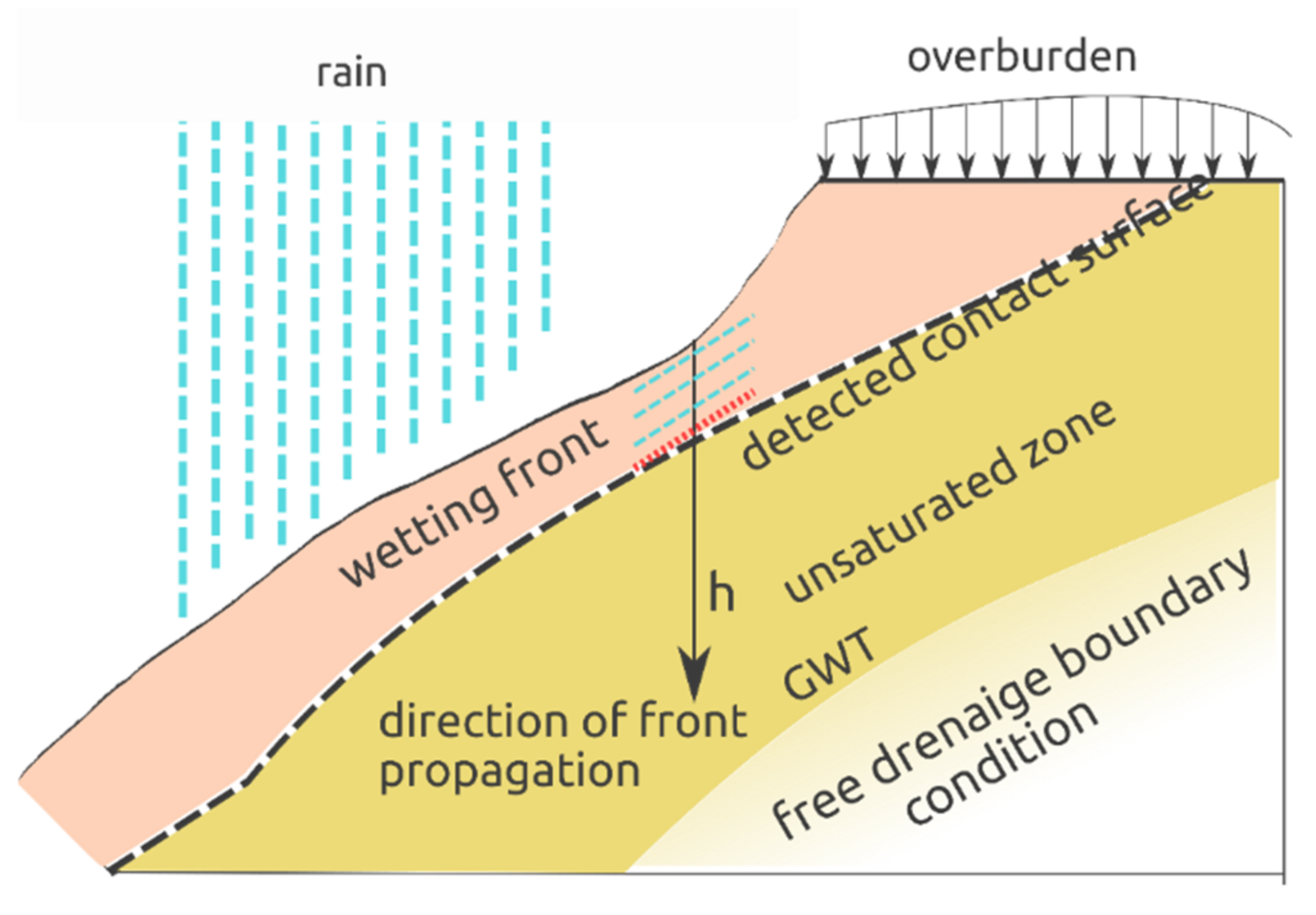
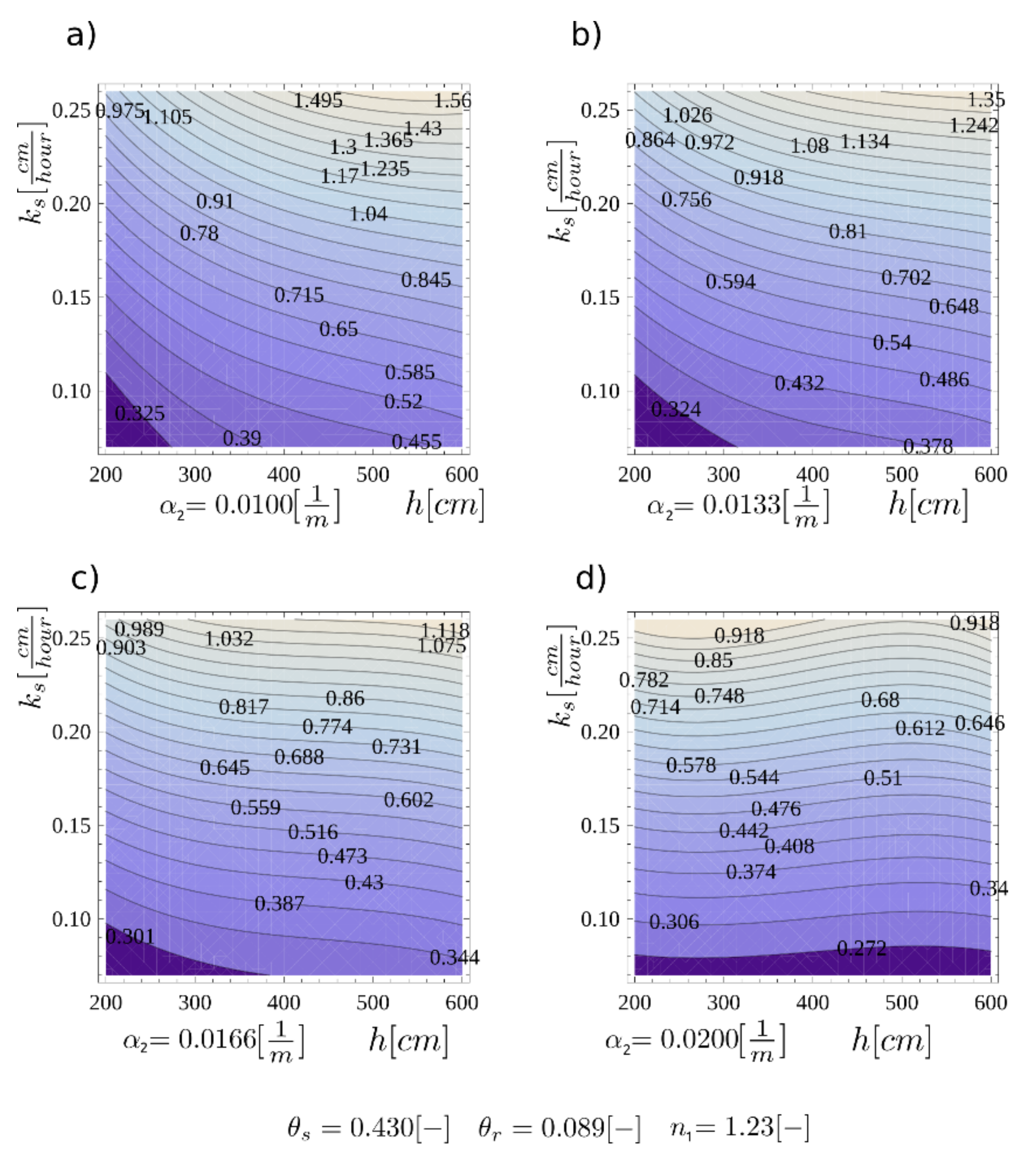
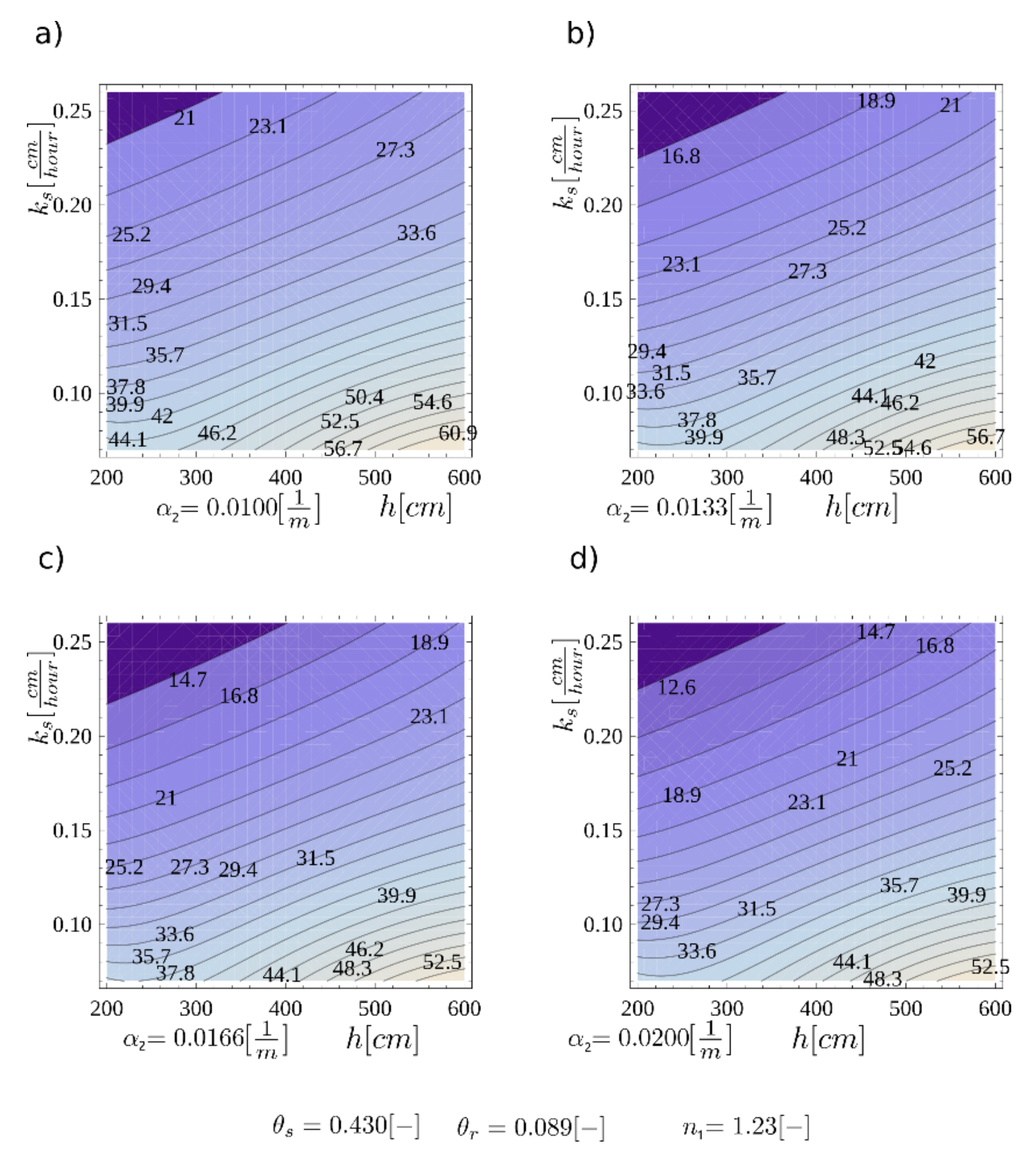
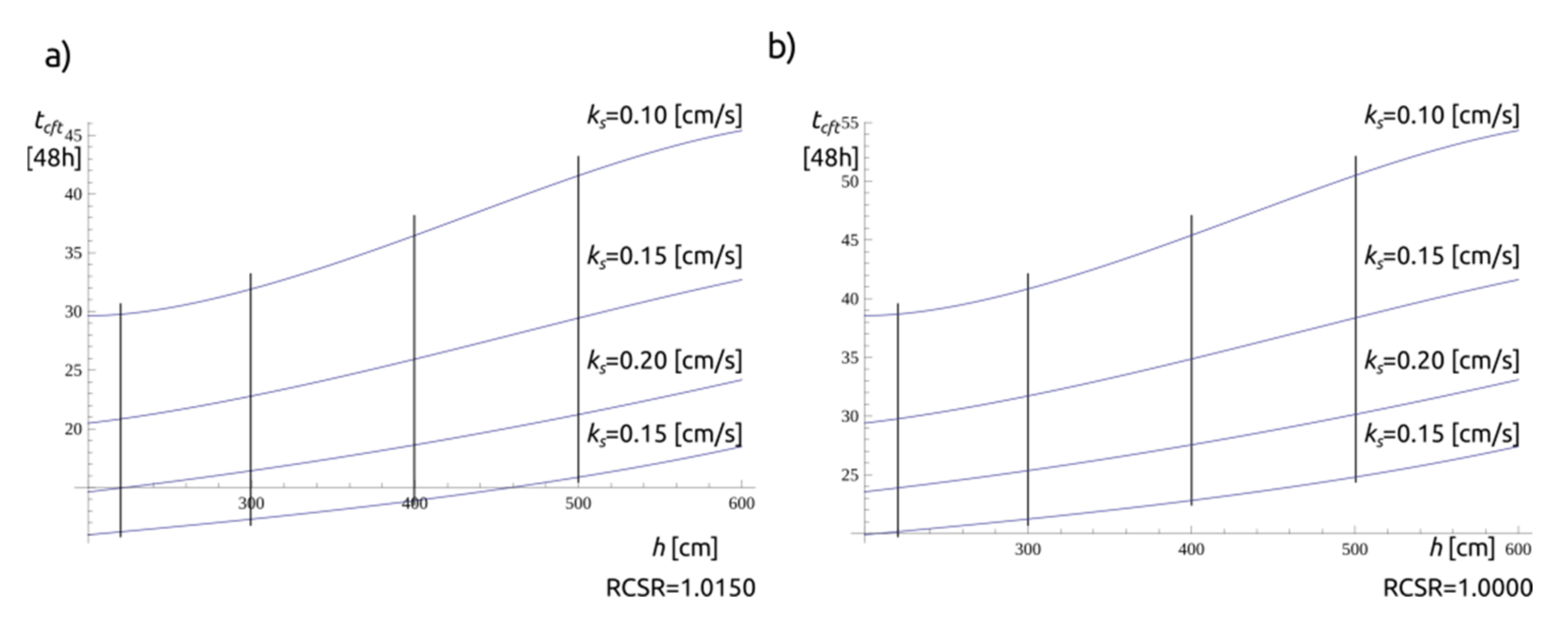
| Test No. | RCSR | t1 (s) | δ1 (mm) | tf (s) | δc (mm) | Remarks |
|---|---|---|---|---|---|---|
| I (1) | 0.9000 | 3526 | 2.3672 | 25,692 | 2.3045 | No failure |
| I (2) | 0.9500 | 6872 | 2.8793 | 26,570 | 2.8840 | No failure |
| I (3) | 1.0000 | 8338 | 3.2688 | 28,844 | 3.3599 | No failure |
| I (4) | 1.0025 | 18,184 | 3.7340 | 54,308 | 3.8970 | Failure |
| Soil | n1 (-) | α2 (m−1) | ks (m/s) |
|---|---|---|---|
| sand | 4–8.5 | 1–5 | 10−2–10−5 |
| silt | 2–4 | 0.1–1 | 10−6–10−9 |
| clay | 1.1–2.5 | 0.01–0.1 | 10−9–10−13 |
Publisher’s Note: MDPI stays neutral with regard to jurisdictional claims in published maps and institutional affiliations. |
© 2021 by the authors. Licensee MDPI, Basel, Switzerland. This article is an open access article distributed under the terms and conditions of the Creative Commons Attribution (CC BY) license (https://creativecommons.org/licenses/by/4.0/).
Share and Cite
Bhat, D.R.; Kozubal, J.V.; Tankiewicz, M. Extended Residual-State Creep Test and Its Application for Landslide Stability Assessment. Materials 2021, 14, 1968. https://doi.org/10.3390/ma14081968
Bhat DR, Kozubal JV, Tankiewicz M. Extended Residual-State Creep Test and Its Application for Landslide Stability Assessment. Materials. 2021; 14(8):1968. https://doi.org/10.3390/ma14081968
Chicago/Turabian StyleBhat, Deepak R., Janusz V. Kozubal, and Matylda Tankiewicz. 2021. "Extended Residual-State Creep Test and Its Application for Landslide Stability Assessment" Materials 14, no. 8: 1968. https://doi.org/10.3390/ma14081968
APA StyleBhat, D. R., Kozubal, J. V., & Tankiewicz, M. (2021). Extended Residual-State Creep Test and Its Application for Landslide Stability Assessment. Materials, 14(8), 1968. https://doi.org/10.3390/ma14081968






